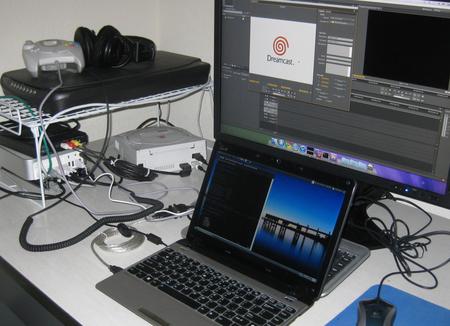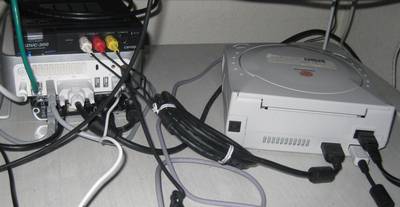Some people are curious about what kind of equipment is required to program a Sega Dreamcast. This is my setup:

It’s a bit overcomplicated. The only piece in that picture which doesn’t play a role in the Dreamcast development process is the scanner. The Eee PC does the heavy lifting of development (i.e., text editing and cross compilation) and uploads to the Dreamcast via a special serial cable. Those are the most essential parts and are really the only pieces necessary for a lot of algorithmic stuff (things that can be validated via a serial console). But then I have to go up a level where I output video. That’s where things get messy.

The Mac Mini and giant monitor really just act as a glorified TV in this case. Ideally, it will be more than that. The DC outputs audio and video via composite cables to a Canopus DV capture bridge. That’s connected via FireWire to the external hard drive underneath the Mac Mini, which is connected to the Mac. Adobe Premiere Pro handles the DV capture / display.
One day I hope to have something worthwhile to capture.
Glad to see SOMEONE taking a renewed interest in the Dreamcast! The homebrew scene, such as it was, seemed to have flourished and died about as quickly as the console.
In a previous article, you were working on getting a Linux 2.6 kernel working. I know you haven’t successfully built it yet, but while I’m good at using a working Linux system, kernel building is relatively unknown to me. I tried a couple times but it seems like I get asked a thousand questions from the build process and never get anywhere. I would really appreciate if you could write up how you performed the Dreamcast build (The GCC steps and config menu, and I know it doesn’t work!) just so I could get some hints for my own exploration…
I followed an old step-by-step to build a working 2.4 kernel that provided all the sources and was pretty direct. But he preconfigured the kernel so I missed that part…
If it’s any help, I have noticed through Googling about that it looks like some people have in history gotten various versions of 2.6 to boot, but none of them wrote up how.